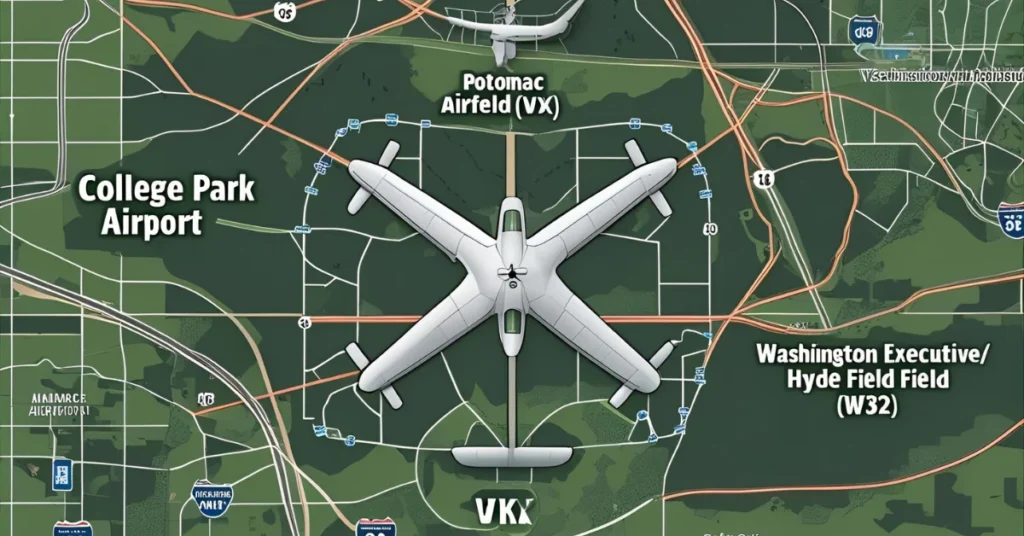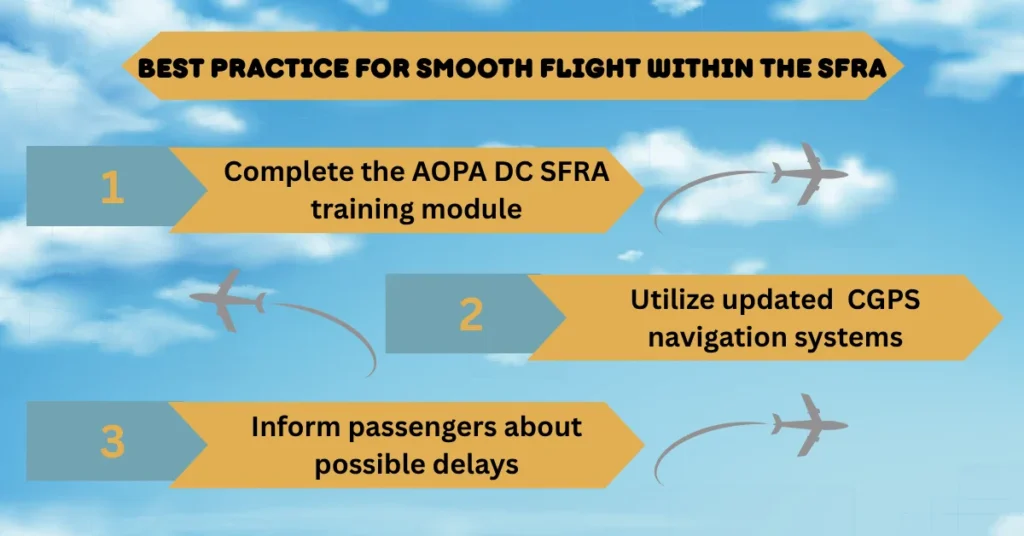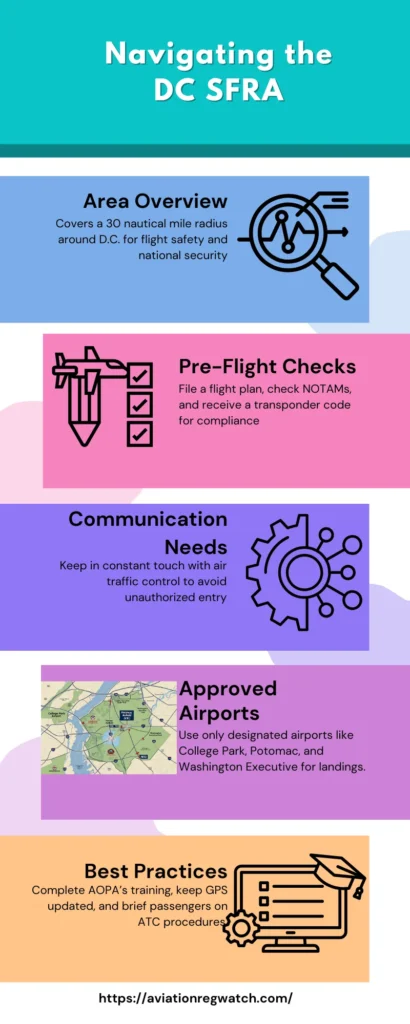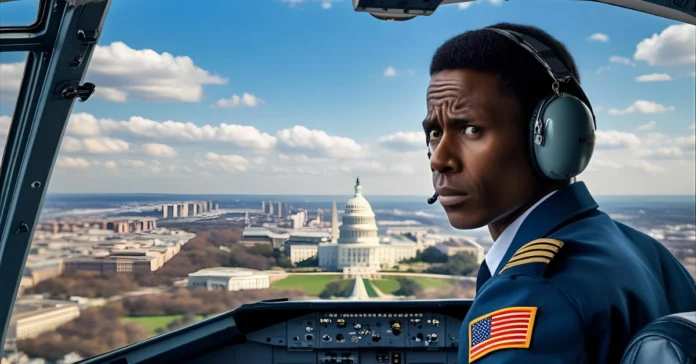Introduction: Understanding the DC SFRA
Understand the DC SFRA rules for safe flying in D.C: The Washington, D.C. Special Flight Rules Area (SFRA) is a crucial segment of airspace designed to ensure the safety of the nation’s capital.
Its purpose is to protect vital government buildings and high-profile events, particularly in the wake of heightened security concerns after the events of September 11, 2001.
The SFRA spans a 30 nautical mile radius around Washington, D.C., creating a dense layer of regulations that pilots must navigate.
Because of its complexity and the strict rules that apply, understanding the SFRA is essential for any pilot operating in or near this crowded and sensitive airspace.
This guide aims to simplify those regulations, making it easier for pilots flying general aviation (GA), air taxi, or ferry flights to comply with the rules and fly safely in this area.
Key Procedures for Entry
When preparing to fly in the DC SFRA, there are several important steps to follow both before takeoff and during flight.
Pre-Flight Requirements:
- Flight Plan Submission: Before you take off, you need to file a flight plan, which can be either Visual Flight Rules (VFR) or Instrument Flight Rules (IFR).
- Discrete Transponder Code: Obtain a unique transponder code from air traffic control (ATC) to ensure your aircraft can be tracked.
- NOTAMs and TFRs: Always check for Notices to Air Missions (NOTAMs) and Temporary Flight Restrictions (TFRs) that might affect your flight route.
In-Flight Obligations:
- Two-Way Communication: Maintain constant communication with air traffic control throughout your flight to receive instructions and provide updates.
- Squawk the Assigned Code: Ensure that your transponder is set to the discrete code provided by ATC.
- Follow ATC Clearances: Do not change your flight path or altitude without prior approval from air traffic control.
Approved Airports Inside the SFRA
If you need to land within the DC SFRA, there are specific airports that are authorized for use:
- College Park Airport (CGS)
- Potomac Airfield (VKX)
- Washington Executive/Hyde Field (W32)

These airports are equipped to handle flights within the regulations of the SFRA.
Why This Matters
Navigating the SFRA can be complicated, and pilots who are unfamiliar with its procedures can easily find themselves in trouble.
In 2023, there were over 80 incidents of unauthorized incursions—times when pilots mistakenly entered restricted areas.
Many of these situations arose from poor planning or a lack of awareness regarding the rules. Understanding and complying with SFRA regulations is vital to avoid serious consequences, including military interception.
Best Practices

To ensure a smooth flight within the SFRA, consider the following best practices:
- AOPA Training: Complete the Aircraft Owners and Pilots Association’s (AOPA) DC SFRA training module. While it may not be mandatory, it provides valuable insights.
- Use GPS Tools: Utilize updated GPS navigation systems that include overlays for SFRA to help you avoid restricted areas.
- Passenger Briefings: Before departure, brief your passengers about the potential for air traffic control holds or flight diversions to keep everyone informed and prepared.
Frequently Asked Questions (FAQs) for Pilots Navigating the DC SFRA
1. What is the SFRA, and why is it important for pilots?
The Special Flight Rules Area (SFRA) around Washington, D.C., is designed to ensure the safety and security of the nation’s capital. It is essential for pilots to understand the SFRA because it encompasses strict regulations that help prevent unauthorized access to sensitive airspace, which is critical for protecting national assets and ensuring public safety.
2. What are the consequences of unauthorized incursions into the SFRA?
Pilots who unintentionally enter the SFRA without the proper clearances can face serious consequences, including interception by law enforcement or military aircraft. In addition, they may receive warning letters from the FAA or even face penalties, which can include the suspension or revocation of their pilot certificates.
3. What steps should I take before flying in the SFRA?
Before flying in the SFRA, pilots should:
- File an appropriate flight plan (VFR or IFR).
- Obtain a discrete transponder code from air traffic control (ATC).
- Review any NOTAMs and TFRs affecting the flight area.
These steps are crucial for ensuring compliance with SFRA regulations and maintaining safety.
4. Which airports are approved for landings within the SFRA?
The main airports approved for landings within the DC SFRA are:
- College Park Airport (CGS)
- Potomac Airfield (VKX)
- Washington Executive/Hyde Field (W32)
Pilots should utilize these airports to ensure they are operating within the legal framework of the SFRA.
5. How can I prepare for changes in air traffic control procedures while flying in the SFRA?
To prepare for potential changes in ATC procedures, pilots should:
- Complete the AOPA’s DC SFRA training module for up-to-date knowledge.
- Stay informed by regularly checking the latest NOTAMs and TFRs.
- Brief passengers on possible ATC holds or diversions.
These preparations can enhance situational awareness and improve overall flight safety.
Conclusion: Navigating with Confidence

In summary, the Washington, D.C. Special Flight Rules Area is a critical zone that every pilot should approach with caution and preparation.
Understanding the entry requirements, knowing the approved airports, and adhering to best practices will not only enhance flight safety but also ease the navigation experience for pilots flying in this heavily regulated airspace.
As air traffic continues to grow and security remains a priority, staying informed about entry and communication protocols within the SFRA is more important than ever.
By following these guidelines, pilots can confidently operate within the SFRA while ensuring compliance with federal regulations—ultimately contributing to the safety and security of all airspace users.

